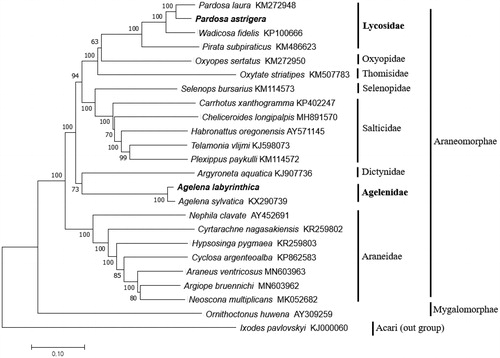Abstract
We performed high-throughput sequencing on the complete mitogenomes of two non-orb-weaving spiders, Pardosa astrigera (wolf spiders; Lycosidae) and Agelena labyrinthica (funnel weaver; Agelenidae). The two mitogenomes contain 14,520 bp and 14,772 bp, and a GC content of 22.5% and 25.5%, respectively. The two mitogenomes contain 13 protein-coding genes (PCGs), 22 transfer RNAs, two ribosomal RNAs, and one control region. Phylogenetic analysis of the concatenated 13 PCGs revealed the clear classification of the two families, based on the data of this study.
The two non-orb-weaving spiders, Pardosa astrigera and Agelena labyrinthica, are found all across Korea. Although, the two spiders are often found in fields and forests, data on their biological characteristics and genetic information are lacking. In this study, to the best of our knowledge, we determined mitochondrial genomes of the two species for the first time.
The P. astrigera (IN5985) and A. labyrinthica (IN5986) were collected from near the Jiri mountain (35°21′49.04″N, 127°31′19.32″E and 35°19′29.54″N, 127°17′59.36″E) in Gurye-gun, Jeollanam-do, South Korea and stored in National Institute of Biological Resources (NIBR) at Incheon, South Korea. Genomic DNA was extracted from tissue (whole body of P. astrigera and four legs of A. labyrinthica) using the DNeasy Blood and Tissue Kit (Qiagen, Valencia, CA, USA) in accordance with the manufacturer’s protocol and deposited in the NIBR. DNA Link Inc. (Seoul, South Korea) performed whole genome resequencing using the Illumina HiSeq 2500 platform. The mitogenome assembly was recovered from the whole genome sequencing data as a single circular contig using MITObim (Hahn et al. Citation2013). Genome annotations were performed using GeSeq (Tillich et al. Citation2017) using NCBI references sequences.
Mitogenome length and AT content of P. astrigera are 14,520 bp and 77.5%, respectively (GenBank accession: MN734266), while those for A. labyrinthica, 14,772 bp and 74.5% (MN603961). The two mitogenomes were predicted to consist of 13 protein-coding genes (PCGs), 22 transfer RNA genes, two ribosomal RNA genes, and one putative control region that are typically present in metazoan mitogenomes (Boore Citation1999). The mitogenome of P. astrigera have four start codons for 13 PCGs: ATT for COI, ND5, ND4L, CYTB and ND1; ATG for ATP6 and ND3; ATA for COII, ATP8, ND4, ND6 and ND1; and TTG for COIII. A. labyrinthica also has four initiation codons: ATT for COI, ND1, ND4, ND5 and CYTB; ATG for ATP6 and ND6; ATA for ND2, ATP8, ND3 and ND4L; and TTG for COII and COIII. In the mitogenome of P. astrigera, four PCGs (ND2, ND3, COI and COII) are terminated with TAG and the rest of nine genes have TAA as a stop codon. On the other hand, in case of A. labyrinthica, five genes (ND2, ND3, ND5, ATP8 and COI) are terminated with TAG and rest of eight genes end with TAA.
We constructed a neighbor-joining tree using MEGA7 (Kumar et al. Citation2016) and the concatenated 13 PCGs sequenced in our study along with 22 Arachnida mitochondrial genomes downloaded from GenBank (). Phylogenetic analysis confirmed the monophyly of Lycodidae and Agelenidae. Two family clustered closely with Salticidae and Thomisidae such as non-orb-weaving spiders, whereas Araneidae was distant. In conclusion, this study provides two new additions to the Araneae mitochondrial genome database, thus enriching in evolutionary and ecological studies pertaining to spiders.
Figure 1. Phylogenetic tree based on concatenated coding genes from the complete mitochondrial genomes of 24 spiders. The sequences were downloaded from Genbank and the phylogenetic tree was constructed by the neighbor-joining method with 1000 bootstrap replicates. Ixodes pavlovskyi was used as an outgroup. The mitochondrial genome of Pardosa astrigera and Agelena labyrinthica in bold were determined and characterized in this study.

Disclosure statement
No potential conflict of interest was reported by the author(s).
Additional information
Funding
References
- Boore JL. 1999. Survey and summary: animal mitochondrial genomes. Nucleic Acids Res. 27(8):1767–1780.
- Hahn C, Bachmann L, Chevreux B. 2013. Reconstructing mitochondrial genomes directly from genomic next-generation sequencing reads- a baiting and iterative mapping approach. Nucleic Acids Res. 41(13):e129–e129.
- Kumar S, Stecher G, Tamura K. 2016. MEGA7: Molecular Evolutionary Genetics Analysis version 7.0 for bigger datasets. Mol Biol Evol. 33(7):1870–1874.
- Tillich M, Lehwark P, Pellizzer T, Ulbricht-Jones E, Fischer A, Bock R, Greiner S. 2017. GeSeq-versatile and accurate annotation of organelle genomes. Nucleic Acids Res. 45(W1):W6–W11.
